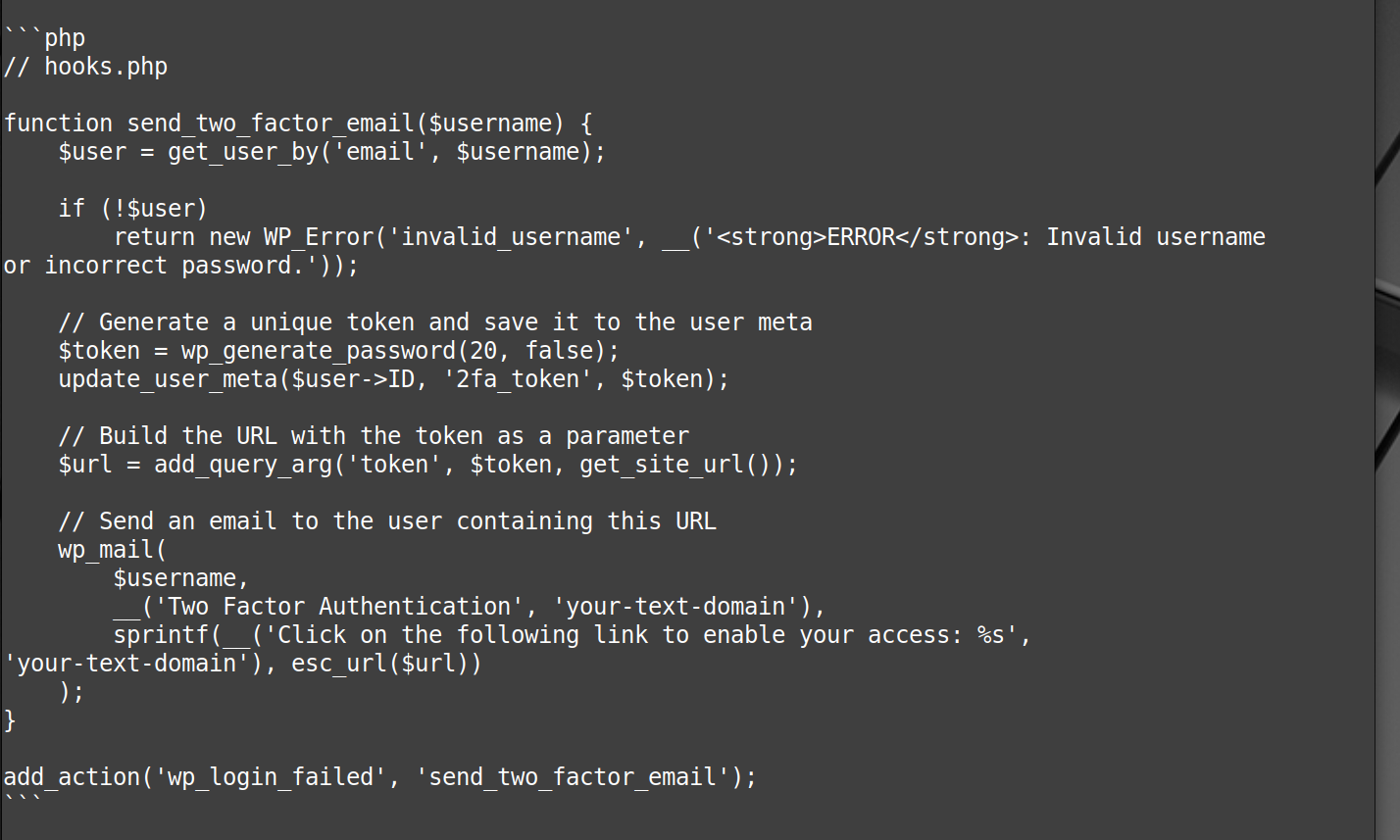2FA Login possibilities.
Ollama model QWQ created these logical steps to a 2FA login.
Using php i need a 2fa login using email with a token link to allow user access to my wordpress site.
So I need to set up a two-factor authentication (2FA) WordPress plugins or advanced PHP, but I think I can figure this out step by step.
Understand what 2FA is.
First, I need to understand what 2FA is. Two-factor authentication is an extra layer of
security that requires not only a password and username but also something that only the user
has access to, like a token. In this case, the token will be sent via email.
I should consider whether there are existing plugins that can do this, since WordPress has a large repository of plugins that might already have this functionality. I don’t want to reinvent the wheel if I don’t have to.
Let me look up some 2FA plugins for WordPress. There are quite a few options, like Google Authenticator, Authy, and some that use email tokens. Wait, one called “Two Factor” seems popular and has different methods including email tokens. Maybe I can use that instead of building my own solution.
But the task is to create this using PHP, so maybe I should build a custom solution for
learning purposes. That way, I can understand how it works under the hood.
Let’s plan this out.
Okay, let’s plan this out. The process should be:
- User enters their username and password on the login page.
- If credentials are correct, generate a token and send it to the user’s email.
- User receives the email with the token link.
- User clicks the token link, which validates the token and grants access to the site.
I need to make sure that the token is unique and expires after a certain time for security
reasons.
First, I need to create a login form where users enter their username and password. Since it’s WordPress, I can probably hook into the existing login process.
I should look into the WordPress authentication API to see how I can intercept the login
attempt and add my own 2FA step. Maybe I can use the ‘authenticate’ filter hooks to add my custom authentication logic.Once the user successfully logs in, I need to generate a token. How should I generate this token? It should be random and hard to guess.I can use PHP’s built-in functions like bin2hex(random_bytes($length)) to generate a secure random token. Let’s say I generate a 32-character hexadecimal token. Then, I need to send this token to the user’s email. I can use WordPress’s built-in email functionality for this. I’ll need to create an email template that includes the token link, something like mysite.com/login?token=generated_token.
But wait, I need to store
But wait, I need to store this token somewhere so that when the user clicks the link, I can validate it. Maybe I can create a database table to store tokens along with user IDs and expiration times.
So, I’ll need to run a SQL query to create a new table, say ‘wp_2fa_tokens’, with columns for token, user_id, creation timestamp, and expiration timestamp.
When generating the token, I’ll insert a row into this table with the token, associated user ID, current timestamp, and a timestamp for expiration, say 15 minutes from now.
Then, in the email, I’ll include a link like mysite.com/login?token=generated_token. Now, when the user clicks the link, I need to validate the token. I’ll create a login page that checks for the ‘token’ parameter in the URL.
First, check if the token exists in the database and hasn’t expired. If it’s valid, then authenticate the user and log them in. After successful validation, I should delete the token from the database to prevent reuse. Also, I need to handle cases where the token is invalid or has expired, and display appropriate messages to the user.
The token
Additionally, I should make sure that the token link is only valid for one use. Once the user logs in with it, it should be invalidated I think deleting the token after use would achieve that. Let me outline the steps again:
- User submits login form with username and password.
- If credentials are correct, generate a token and store it in the database linked to the user’s ID and set an expiration time.
- Send an email to the user with a link containing the token.
- User clicks the link, which directs to a login page with the token parameter.
- The login page checks if the token is valid and not expired.
- If valid, log the user in and delete the token.
- If invalid or expired, display an error message.
I need to ensure that the token is securely generated and that the email transmission is
secure, especially since it contains a link for authentication. Also, I should consider using HTTPS for the site to encrypt the connection. Assuming that the site already uses HTTPS, which is important for security. Now, let’s think about implementing this in WordPress.I can create a custom plugin for this functionality.
Custom_2fa.php
First, I need to set up a new plugin file, say ‘custom_2fa.php’. Then, I need to hook into the login process. I can use the ‘wp_authenticate_user’ action to check if the credentials are correct and then proceed to send the token email.
Wait, perhaps a better hook is ‘authenticate’, which allows me to filter the authentication
process. But I need to make sure that after successful authentication, I can intercept before the user is logged in and send the token email. Alternatively, maybe I can use the ‘wp_login’ action, which fires after a user logs in, but then how do I introduce the 2FA step before actually logging in?
Hmm
Hmm, maybe I need to create a custom login flow.
I am waiting to see what this AI model does with my request to add to this.
Ollama Model Opencoder
ollama run opencoder
Can you provide php script for wordpress to modify login using email verification?
Modify WordPress Login
Sure, here is a simple way to modify the default WordPress login process so it verifies users with their email instead of username.
Please note that this is a simple example and does not cover all possible edge cases or
security implications, but should give you an idea of how you can modify the login process to
verify users by email.You would also need to handle password resets via email. WordPress natively supports
username/password logins only. Modifying it to support email addresses as well will require a
significant amount of code and is not recommended unless absolutely necessary.
Yes, I need 2fa process where email of user is sent with a link that enables their access.
Implementing two-factor authentication (2FA) via email in WordPress would be a complex task because WordPress does not inherently support this feature. However, you can use plugins or custom code to achieve this.
For example, the “Two Factor Authentication” plugin by WPWhale
(https://wordpress.org/plugins/two-factor-authentication/) is very popular and offers 2FA via email. You would simply install & configure it as per the instructions provided in its documentation.
Alternatively, you could use custom code to send a unique URL to the user’s email address upon login attempt, which when clicked would confirm their identity and enable them access.
Example OF 2FA Code
Here is an example of a function that sends a 2FA link via email:
// hooks.php
function send_two_factor_email($username) {
$user = get_user_by('email', $username);
if (!$user)
return new WP_Error('invalid_username', __('<strong>ERROR</strong>: Invalid username
or incorrect password.'));
// Generate a unique token and save it to the user meta
$token = wp_generate_password(20, false);
update_user_meta($user->ID, '2fa_token', $token);
// Build the URL with the token as a parameter
$url = add_query_arg('token', $token, get_site_url());
// Send an email to the user containing this URL
wp_mail(
$username,
__('Two Factor Authentication', 'your-text-domain'),
sprintf(__('Click on the following link to enable your access: %s',
'your-text-domain'), esc_url($url))
);
}
add_action('wp_login_failed', 'send_two_factor_email');When a user tries to login, this function is triggered and sends an email containing a
unique URL with a 2FA token. They would need to click on the link to enable access.
Remember- Security
Remember that for security reasons you should also implement checks within your application which validate the 2FA token upon each subsequent request or operation performed by the user.
Ollama Model Opencoder login with HTML
ollama run opencoder
Can you provide php script for html website to modify login using email verification?
Certainly! Below is an example of a PHP script that can be used to verify user’s email
during the login process.
This simple script assumes that you have a users table in your database with columns like ’email’, ‘password’ and ‘verified’. This script checks if the provided email exists, if not, it redirects back. It also verifies the password and checks whether the user is verified or not.
Example- login Script
<?php
// Start session
session_start();
$db_host = "localhost";
$db_name = "database";
$db_user = "user";
$db_pass = "password";
// Connect to database
try {
$conn = new PDO("mysql:host=$db_host;dbname=$db_name", $db_user, $db_pass);
$conn->setAttribute(PDO::ATTR_ERRMODE, PDO::ERRMODE_EXCEPTION);
} catch (PDOException $e) {
echo "Connection failed: " . $e->getMessage();
die();
}
if(isset($_POST['login'])){
// Sanitize the inputs
$email = htmlspecialchars(strip_tags(trim($_POST["email"])));
$password = htmlspecialchars(strip_tags(trim($_POST["password"])));
// Prepare SQL statement to prevent SQL injection
$stmt = $conn->prepare("SELECT * FROM users WHERE email=:email");
$stmt->execute(['email' => $email]);
$user = $stmt->fetch();
if($user && password_verify($password, $user['password']) && $user['verified'] == 1){
// User exists and password is correct
$_SESSION["loggedin"] = true;
$_SESSION["id"] = $user["id"];
header("location: welcome.php");
} else {
// Invalid credentials
echo "Invalid email or password.";
}
}
?>This code should be integrated with your HTML login form.
Please note, for the best security practice you need to hash passwords before saving them
into the database. This is a simplified example and doesn’t contain error handling, so
please consider those aspects for production use. Also, this script assumes that the
‘verified’ column in your users table uses 1 for verified users and 0 for unverified users.
PHP/HTML Example with 2FA login using Email
I also need a 2FA poccess using user email with a token in email link to authorizes access to
… configurable home page and a login page with a 2FA requirement noted at top of login page all
… in PHP and MYsql commands for database
Sure, here’s a simple example how you could set up two-factor authentication (2FA) using
email with PHP and MySQL:
<?php
// Database connection parameters
$db_host = "localhost";
$db_name = "database";
$db_user = "user";
$db_pass = "password";
try {
$conn = new PDO("mysql:host=$db_host;dbname=$db_name", $db_user, $db_pass);
$conn->setAttribute(PDO::ATTR_ERRMODE, PDO::ERRMODE_EXCEPTION);
} catch (PDOException $e) {
echo "Connection failed: " . $e->getMessage();
die();
}
// Handle login form submission
if(isset($_POST['login'])){
// Sanitize the inputs
$email = htmlspecialchars(strip_tags(trim($_POST["email"])));
$password = htmlspecialchars(strip_tags(trim($_POST["password"])));
// Prepare SQL statement to prevent SQL injection
$stmt = $conn->prepare("SELECT * FROM users WHERE email=:email");
$stmt->execute(['email' => $email]);
$user = $stmt->fetch();
if($user && password_verify($password, $user['password'])){
// User exists and password is correct
// Generate a token for 2FA
$token = bin2hex(random_bytes(16));
// Insert token into database
$stmt = $conn->prepare("UPDATE users SET token=:token WHERE email=:email");
$stmt->execute(['token' => $token, 'email' => $email]);
// Send token via email
$headers = "From: noreply@example.com";
mail($user['email'], '2FA Verification', "Please use the following token to log in:
$token", $headers);
header("location: 2fa_form.php");
} else {
echo "Invalid credentials.";
}
}
?>For the 2FA form (2fa_form.php):
<!DOCTYPE html>
<html lang="en">
<head>
<meta charset="UTF-8">
<title>2FA Verification</title>
</head>
<body>
<form method="POST" action="process_2fa.php">
<label for="token">Token:</label><br>
<input type="text" id="token" name="token"><br>
<input type="submit" value="Submit">
</form>
</body>
</html>And the processing script (process_2fa.php):
<?php
// Database connection parameters are defined as above
if(isset($_POST['login'])){
// Sanitize the inputs
$token = htmlspecialchars(strip_tags(trim($_POST["token"])));
// Prepare SQL statement to prevent SQL injection
$stmt = $conn->prepare("SELECT * FROM users WHERE token=:token");
$stmt->execute(['token' => $token]);
$user = $stmt->fetch();
if($user){
$_SESSION['loggedin'] = true;
header("location: home.php");
} else {
echo "Invalid token.";
}
}
?>
Remember
Remember to replace the database connection parameters, and replace “noreply@example.com”, “2FA Verification” and “home.php” with your own data. Also please make sure that you have a valid mail server set up to send mails. The above code doesn’t handle errors and exceptions properly for simplicity.





Leave a Reply